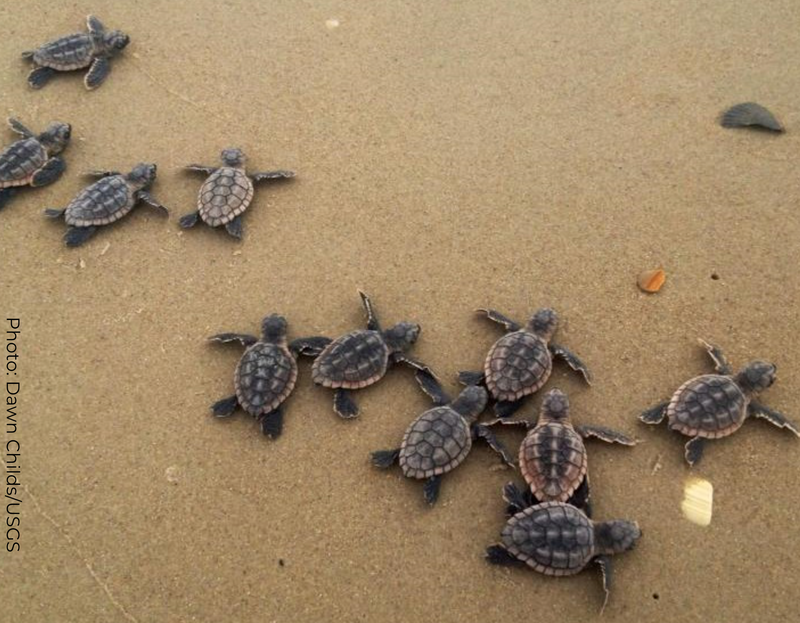
Federal Agency Cooperation in Protecting Species

Federal Agency Cooperation in Protecting Species
Every year, thousands of baby loggerhead sea turtles hatch along 1,300 miles of the beaches in the southeastern U.S. In a good year, these beaches can be the home of up to 90,000 nests. Then, 80 days later, under the cover of night, thousands of loggerhead sea turtle hatchlings dig out from the sandy nests and make their way toward the open ocean, using the light of the moon to navigate their way. Despite these astounding numbers, populations of loggerhead turtles have been on the decline, threatened by predation, habitat loss, and even conflict with human activities. As a result of these threats, in 1978, the loggerhead was listed as threatened under the Endangered Species Act (ESA). And the loggerhead is not alone - as of 2016, all five species of sea turtles in the United States are listed as threatened or endangered.
The ESA has many proactive components to help move a species toward recovery, but it also must protect listed species from backsliding as regular activities continue to occur. Section 7 of the ESA does exactly this. It has provisions to protect species - like sea turtles - from extinction as a result of federal actions. Examples of this “federal nexus” include construction of a highway or bridge, or the building of a new resort along coast lines where federal actions, permits, or funding is needed. Section 7 of the ESA requires all federal agencies to help protect threatened and endangered species and is often considered the strongest part of the law.
One key part of section 7 is referred to as the consultation process, which exists to ensure that species are not jeopardized and that their critical habitat is not destroyed. Federal agencies must consult with either FWS and/or the National Marine Fisheries Service (NMFS), depending on which agency is responsible for impacted species. By going through a consultation, federal agencies figure out how they can help ensure they conduct activities - like construction - in the safest way possible to give species the best possible chance at recovery. Little things like how and when to use construction lighting can ensure that each year, sea turtle hatchlings don’t mistakenly make their way toward the bright lights of machinery instead of out toward the ocean.
Sea turtles are a unique case, since they spend part of their lives on the coastal, sandy beaches and part out in marine waters. Because of this, they’re managed by both the FWS and NMFS. Both Services have to follow the same rules and regulations outlined by the section 7 process - but in practice, do they?
Sea turtles, including the loggerhead, provided Defenders with a scenario to examine this exact question. In new research published in PLoS One, the team examined over 100 cases of how FWS and NMFS approach the section 7 process specifically on actions that could affect sea turtles to see how the details of implementation differed. Did both Services include similar measures to keep turtles safe? Did they both consider the effect of previous actions on the turtles?
The data show that NMFS sea turtle consultations were 1.4 times as likely to be more complete than those done by FWS and address the necessary details. Both FWS and NMFS frequently failed to account for the effects of previous consultations and the potential for compounded effects on turtle species.
“The details of these consultations matter. When agencies fall short of their own guidance - for example if they don’t carefully take into account the effects of previous actions - sea turtle populations may be harmed more than we think. But how these consultations are conducted and what actions they recommend are crucial for preventing the extinction of all listed species.”
~ Meg Evansen, Conservation Science and Policy Analyst in CCI and lead author of the study
Based on the results of this research, Defenders made several recommendations on how the Services could improve consultations to better protect imperiled species. For example, they need a single database in which to record all of the harm they authorize for ESA-listed species, which currently does not happen. They can also make better use of “programmatic” consultations that analyze the effects of many actions at once and can offer both more efficiency and better protections if done correctly. These and the other recommendations are particularly important because FWS and NMFS are in the process of revising their consultation handbook.
While the details of things like whether “programmatic” consultations work better than single consultations, or whether FWS and NMFS have considered how previous federal action may have affected a species, may seem small, they’re crucial for understanding how to best recover the species day to day. Consultations that address threats to sea turtles may recommend special construction lighting or using specific fishing nets that prevent turtles from getting tangled; how frequently and consistently these recommendations are assessed and implemented can mean the difference between imperiled species - like the loggerhead - getting closer to recovery or sliding down toward extinction.